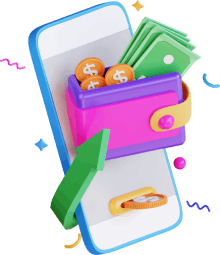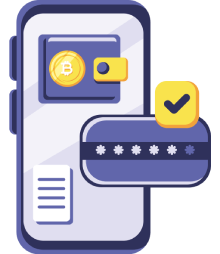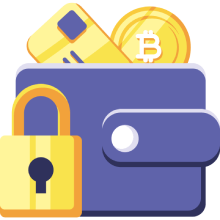Step 1: Choose the Type of Wallet to Suit Your Needs
Before you go through the creation of a wallet, you ought to put into considerations the type that suits your needs. These are the two major categories of crypto wallets:

Hot Wallets
While hot wallets are wallets connected to the internet, one can say these are best suited for users who need quick and frequent access to their funds. Any hot wallet is good to have a small to medium amount of cryptocurrencies, keeping them for frequent use. Popular hot wallets include:
- Software Wallets: Applications installed on your smartphone or computer, like Trust Wallet, MetaMask, or Exodus.
- Web Wallets: Accessed through a web browser, such as Coinbase Wallet or Blockchain Wallet.
Cold Wallets
Cold wallets are offline and safer for long-term storage. These are suitable for those guys who want to load and stash away tons of crypto for quite a while. Types of cold wallets include:
- Hardware Wallets: Tough little gizmos such as Ledger Nano and Trezor.
- Paper Wallets: A piece of paper containing your public and private keys, which you store away.
The easiest and fastest way for a beginner is usually a hot wallet.
Step 2: Download or Purchase Your Wallet
Having chosen which type of wallet, it has to be actually obtained.

For Hot Wallets
- Software Wallet: Go to the official website or to the app store for the wallet of your choice (for example Trust Wallet or MetaMask). Be sure not to download the wallet from somewhere else as it could be a scam.
- Web Wallets: Create an account at a reputable service (for example, Coinbase Wallet).
For Cold Wallets
- Hardware Wallets: Purchase the actual physical device from an official seller, such as Ledger or Trezor. Do not buy via third-party sellers to avoid tampering.
- Paper Wallets: Generate your paper wallet through trusted platforms like bitaddress.org or myetherwallet.com, and then make sure to print and store it securely.
Step 3: Set Up Your Wallet
Building a crypto wallet is incredibly easy; however, setting it up and following the instructions carefully to secure your funds is quite important.
- Open the Wallet App or Device: In the case of software wallets, go and open the app on your phone or computer. When using a hardware wallet, plug in the device to your computer.
- Create a New Wallet: Follow all directions to create a new wallet. While doing so, you will be required to set up a strong password or PIN for your wallet.
- Backup Your Recovery Phrase: In most cases, wallets will generate a recovery phrase for you, comprising about 12 to 24 words. That phrase is essential for you to be able to restore your wallet in such cases where you lose wallet access. Make sure to write it down on paper and place it somewhere very safe.
- Confirm Your Recovery Phrase: In order to be sure that you have correctly noted down your recovery phrase, you will be asked to input the recovery phrase again as part of the setup. Again, this procedure will be helpful in setting up your wallet in a secure manner.
Step 4: Secure Your Wallet
Your wallet being set up, it is time now for the security part of your crypto wallet setup:

Use a Strong, Unique Password
Changing your passwords can help keep unauthorized people out. Use an unpredictable password containing a mixture of letters, numbers, and symbols.
Enable Two-Factor Authentication (2FA)
For additional security, enable two-factor authentication (2FA). This means, along with your password, you will be prompted to enter a second verification code (which is usually sent to your phone) to access your wallet.
Keep Your Recovery Phrase Safe
Your recovery phrase is the key piece of data that must be kept safely. Record it offline in a secure place like a safe or vault. Share it with no one and never post it online.
Step 5: Fund Your Wallet
Once your wallet has been set up, you are all set to use it. It must initially be funded so that cryptocurrencies can be sent and received.
- Get Wallet Address: Your Wallet will give a Public key (Usually in the form of QR Code or alphanumeric string). Using this address, people sending you Crypto can identify you.
- Buy Crypto: Funding your wallet will require purchasing crypto on an exchange (e.g., Coinbase, Binance, or Kraken) and sending it over to your wallet public address.
- Transfer Crypto to Your Wallet: When you go to make a transfer, be sure to type in the correct address. Crypto transfers cannot be reversed, so it pays to double, even triple, check before confirming one.
Step 6: Use Your Wallet
Now that your wallet has been loaded, without further delays, you can actually begin using it to send and receive Crypto. To send funds:
- Obtain the Recipient's Wallet Address: To send cryptocurrency, the public address of the recipient will be needed.
- Enter the Amount and Confirm: Type the amount of cryptocurrency you wish to transfer, check the address again, and confirm the transaction.
Bear in mind that hot wallets usually oversee faster transactions than cold wallets, wherein you may be required to plug in your hardware device to effectuate the transfer.
⭐Congrats! You’ve Created Your Crypto Wallet
Making a crypto wallet is an easy step and probably the most important action when managing your cryptocurrency. Once you have implemented these steps, picked a certain type of wallet, secured the wallet, and funded it, you are ready to enter the world of digital assets. Remember, however, to always maintain security in mind and to always store your recovery phrase safely, since it serves as the key to retrieving your wallet if anything should go wrong.
In case you missed
There are two main types of wallet:
— Defi Krab 🦀 (@Defi_Krab) August 16, 2025
1. Hot Wallet: These are online wallets. We can download them on our devices (Less secure).
Eg: Metamask, Solflare, Nightly...
2. Cold Wallet: These are offline wallets. It is a physical type of wallet (more secure).
Eg: Ledger, Keystone... pic.twitter.com/RiChEJRNq1